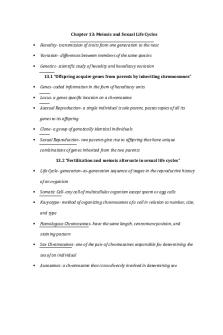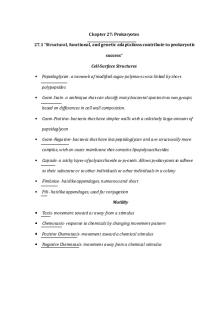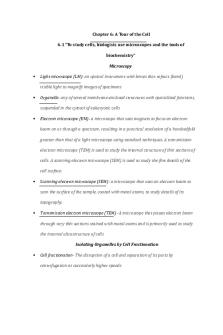Chapter 7 Vocab - Summary Campbell Biology PDF

| Title | Chapter 7 Vocab - Summary Campbell Biology |
|---|---|
| Course | Introduction to Biology A |
| Institution | University of Pennsylvania |
| Pages | 5 |
| File Size | 104 KB |
| File Type | |
| Total Downloads | 31 |
| Total Views | 152 |
Summary
Vocab definitions...
Description
Chapter 7: Membrane Structure and Function Overview: Life at the Edge
Selective Permeability - a property of biological membranes that allows them to regulate the passage of substances across them 7.1 “Cellular membranes are fluid mosaics of lipids and protein”
Amphipathic- having both a hydrophilic region and a hydrophobic region
Fluid Mosaic Model- the currently accepted model of cell membrane structure, which envisions the membrane as a mosaic of protein molecules drifting laterally in a fluid bilayer of phospholipids. Membrane Proteins and Their Functions
Integral Protein- a transmembrane protein with hydrophobic regions that extend into and often completely span the hydrophobic interior of the membrane and with hydrophilic regions in contact with the aqueous solution on one or both sides of the membrane (or lining the channel in the case of a channel protein).
Peripheral Protein- a protein loosely bound to surface of a membrane or to part of an integral protein and not embedded in the lipid bilayer The Role of Membrane Carbohydrates in Cell-Cell Recognition
Glycolipid- a lipid with one or more covalently attached carbohydrates
Glycoprotein- a protein with one or more covalently attached carbohydrates 7.2 “Membrane structure results in selective permeability” Transport Proteins
Transport Protein- a transmembrane protein that helps a certain substance or class of closely related substances to cross the membrane
Aquaporin- a channel protein in the plasma membrane of a plant, animal or microorganism cell that specifically facilitates osmosis, the diffusion of free water across the membrane 7.3 “Passive transport is diffusion of a substance across a membrane with no energy investment”
Diffusion- the spontaneous movement of a substance down its concentration or electrochemical gradient, from a region where it is more concentrated to a region where it is less concentrated.
Concentration Gradient- a region along which the density of a chemical substance increases or decreases.
Passive Transport- the diffusion of a substance across a biological membrane with no expenditure of energy Effects of Osmosis on Water Balance
Osmosis- the diffusion of free water across a selectively permeable membrane Water Balance of Cells Without Walls
Tonicity- the ability of a solution surrounding a cell to cause that cell to gain or loose water.
Isotonic- referring to a solution that, when surrounding a cell, causes no net movement of water into or out of a cell
Hypertonic- referring to a solution that, when surrounding a cell, will cause the cell to lose water
Hypotonic- referring to a solution that, when surrounding a cell, will cause the cell to take up water
Osmoregulation- regulation of solute concentrations and water balance by a cell or organism Water Balance of Cells with Walls
Turgid- swollen or distended, as in plant cells. (A walled cell becomes turgid if it has a lower water potential then its surroundings, resulting in entry of water.
Flaccid- lacking turgor (stiffness or firmness), as in the plant cell in surroundings where there is a tendency for water to leave the cell. (A wall cell becomes flaccid if it has a higher water potential than its surroundings, resulting in the loss of water.)
Plasmolysis- a phenomenon in walled cells in which the cytoplasm shrivels and the plasma membrane pulls away from the cell wall; occurs when the cell loses water to a hypertonic environment Facilitated Diffusion: Passive Transport Aided by Proteins
Facilitated Diffusion- the passage of molecules or ions down their electrochemical gradient across a biological membrane with the assistance of specific transmembrane transport proteins, requiring no energy expenditure.
Ion Channels- a transmembrane protein channel that allows a specific ion to diffuse across the membrane down its concentration or electrochemical gradient.
Gated Channels- a transmembrane protein channel that opens or closes in response to a particular stimulus 7.4 “Active transport uses energy to move solutes against their gradients” The Need for Energy in Active Transport
Active Transport- the movement of a substance across a cell membrane against its concentration gradient, mediated by specific transport proteins and requiring an expenditure of energy
Sodium-Potassium Pump- a transport protein in the plasma membrane of animal cells that actively transports sodium out of the cell an potassium into the cell Maintenance of Membrane Potential by Ion Pumps
Membrane Potential - the difference in electrical charge (voltage) across a cell's plasma membrane due to the differential distribution of ions. Membrane potential affects the activity of excitable cells and the transmembrane movement of all charged substances.
Electrochemical Gradient- the diffusion gradient of an ion, which is affected by both the concentration difference of an ion across a membrane (a chemical force) and the ion's tendency to move relative to the membrane potential (an electrical force).
Electrogenic Pump- an active transport protein that generates voltage across a membrane while pumping ions.
Proton Pump- an active transport protein in a cell membrane that uses ATP to transport hydrogen ions out of a cell against their concentration gradient, generating a membrane potential in the process Cotransport: Coupled Transport by a Membrane Protein
Cotransport - the coupling of the "downhill" diffusion of one substance to the "uphill" transport of another against its own concentration gradient 7.5 “Bulk transport across the plasma membrane occurs by exocytosis and endocytosis”
Exocytosis
Exocytosis- the cellular secretion of biological molecules by the fusion of vesicles containing them with the plasma membrane. Endocytosis
Endocytosis- cellular uptake of biological molecules and particulate matter via formation of vesicles from the plasma membrane.
Ligands- molecule that binds specifically to another molecule, usually a larger one. Endocytosis in Animal Cells
Phagocytosis- a type of endocytosis in which large particulate substances or small organisms are taken up by a cell. It's carried out by some protists and by certain immune cells of animals.
Pinocytosis- a type of endocytosis in which the cell ingests extracellular fluid and its dissolved solutes
Receptor-Mediated Endocytosis- the movement of specific molecules into a cell by the inward budding of vesicles containing proteins with receptor sites specific to the molecules being taken in; enables a cell to acquire bulk quantities of specific substances...
Similar Free PDFs

Ch26 - Summary Campbell Biology
- 6 Pages
Popular Institutions
- Tinajero National High School - Annex
- Politeknik Caltex Riau
- Yokohama City University
- SGT University
- University of Al-Qadisiyah
- Divine Word College of Vigan
- Techniek College Rotterdam
- Universidade de Santiago
- Universiti Teknologi MARA Cawangan Johor Kampus Pasir Gudang
- Poltekkes Kemenkes Yogyakarta
- Baguio City National High School
- Colegio san marcos
- preparatoria uno
- Centro de Bachillerato Tecnológico Industrial y de Servicios No. 107
- Dalian Maritime University
- Quang Trung Secondary School
- Colegio Tecnológico en Informática
- Corporación Regional de Educación Superior
- Grupo CEDVA
- Dar Al Uloom University
- Centro de Estudios Preuniversitarios de la Universidad Nacional de Ingeniería
- 上智大学
- Aakash International School, Nuna Majara
- San Felipe Neri Catholic School
- Kang Chiao International School - New Taipei City
- Misamis Occidental National High School
- Institución Educativa Escuela Normal Juan Ladrilleros
- Kolehiyo ng Pantukan
- Batanes State College
- Instituto Continental
- Sekolah Menengah Kejuruan Kesehatan Kaltara (Tarakan)
- Colegio de La Inmaculada Concepcion - Cebu














